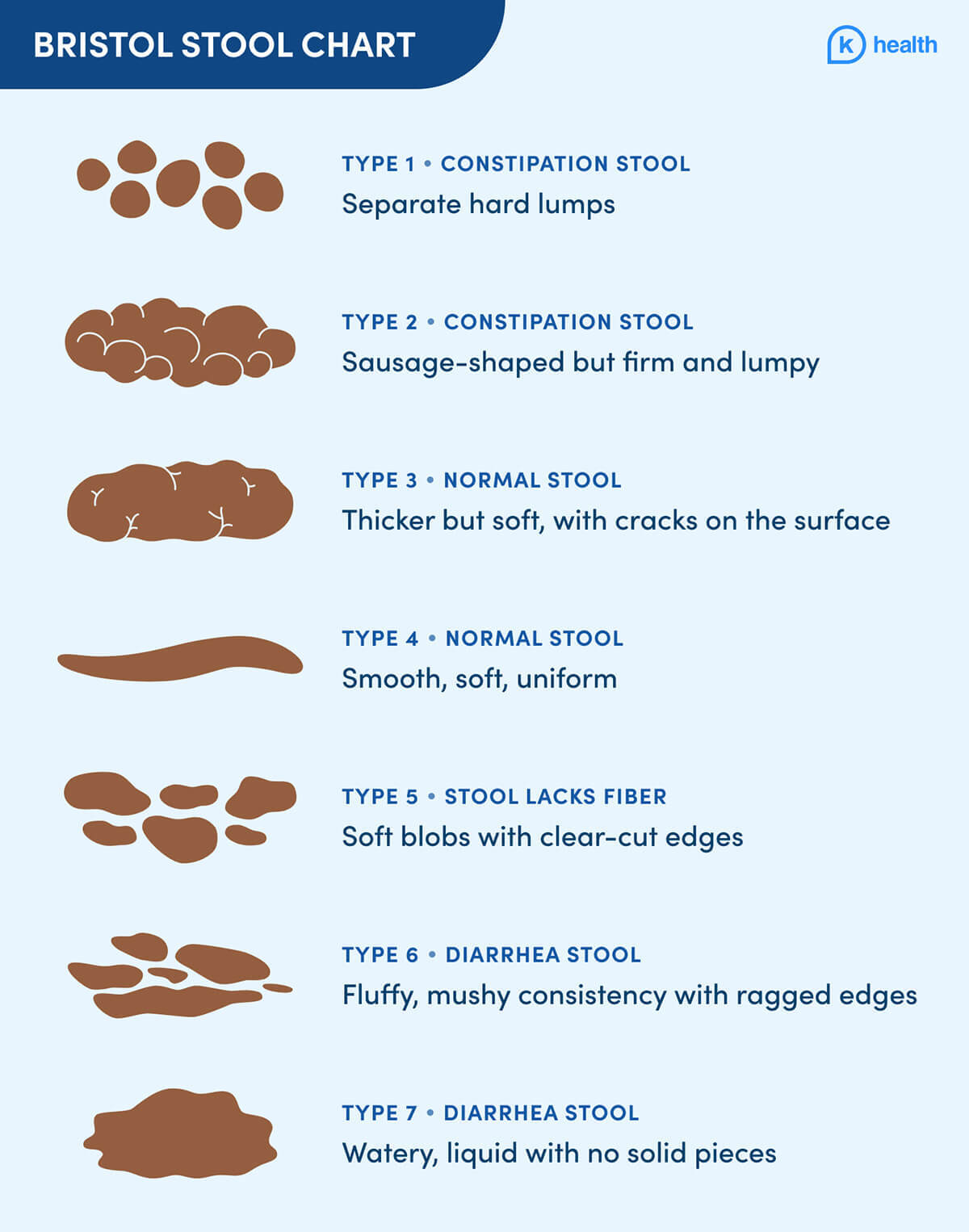Whether we admit it or not, changes in our stool happen.
These changes can be a result of a myriad of factors, including diet, stress, disease, or infection.
Though not the most pleasing task, keeping an eye on the size, appearance, or even smell of your stool can help you to track important changes in your health.
However, in many cases, tracking the changes in your stool isn’t enough.
After all, how will you know which changes, if any, mean anything? Having a guide to follow to help you understand what certain changes in your stool may indicate can help you to know whether or not to seek help from a healthcare professional.
Thankfully, the Bristol Stool Chart was created for exactly that purpose.
Historically used as a clinical assessment tool, today the Bristol Stool Chart is used by medical professionals and patients alike to classify and monitor stool health.
In this article, we explain the origins of the Bristol Stool Chart and how it may help you to better understand and improve your bowel movements.
What Is the Bristol Stool Chart?
The Bristol Stool Chart was developed in 1997 as a clinical assessment tool.
Using data from a study of nearly 2,000 men and women collected from people in the British city of Bristol, the chart classifies stool into seven different types.
These seven categories are based on the records collected from three consecutive defecations of study participants in 1992.
Today, the chart is used to evaluate the shape and type of stool.
It’s also used to diagnose constipation, diarrhea, and irritable bowel syndrome (IBS), as well as to evaluate the efficacy of treatments used to treat different diseases of the bowel.

Types of Stool
The Bristol Stool Chart classifies stool into seven different categories.
Types 1 and 2 identify constipation, types 3-4 indicate healthy stools, and types 5-7 are used to identify diarrhea, urgency, and other causes of loose, watery stools.
Type 1
Type 1 stool identifies the hardest form of stool that is small and lumpy in appearance.
This type of stool can look like rocks, pebbles, or nuts and can be difficult or painful to pass.
Other names sometimes used to describe type 1 stool include:
- Marbles
- Rabbit droppings
Type 1 stool indicates severe constipation.
Type 2
Type 2 stool also indicates constipation but is more formed than type 1.
Type 2 stool may look like a lumpy sausage and can also cause some discomfort or pain when passing.
Other names sometimes used to describe type 2 stool include:
- Caterpillar
- Bunch of grapes
Type 2 stool indicates mild or slight constipation.
Type 3
Type 3 stool is one of two types that indicate healthy stool.
Type 3 stool may look like a sausage but will not appear as lumpy as type 2 stool.
Type 3 may also have cracks on the surface but should not cause pain or significant discomfort when passed.
Other names sometimes used to describe type 3 stool include:
- Hot dogs
- Corn on the cob
Talk to a doctor from home.
Start my visitType 4
Type 4 stool also indicates healthy stool.
Type 4 stools can be long and/or rounded in shape like a sausage but will appear more smooth and soft in texture than type 3.
Other names sometimes used to describe type 3 stool include:
- Snake
- Sausage
Type 5
Type 5 stool is the first of three types that indicate diarrhea.
Type 5 stools appear in separate pieces, similar to type 1, but they are soft instead of hard.
This type of stool may also have clear-cut edges. Unlike type 1, they are passed easily and usually don’t cause discomfort.
Other names sometimes used to describe type 5 stool include:
- Chicken nuggets
- Amoebas
Type 6
Type 6 stool is the second of three types that indicate diarrhea.
Type 6 stools are fluffy in appearance and, unlike type 5, will have ragged rather than clear-cut edges.
In most cases, type 6 stools are mushy rather than formed in appearance.
Other names sometimes used to describe type 6 stool include:
- Soft serve
- Porridge
Type 7
Type 7 stool is the final type of stool that indicates diarrhea.
Type 7 stools are very loose and watery and will not have any form or shape to them.
Type 7 stools indicate severe diarrhea.
Other names sometimes used to describe type 7 stool include:
- Jackson Pollock
- Gravy
Good Bowel Functions
What constitutes a healthy bowel function will not be the same for every person.
Healthy bowel functions can come in a range of appearances and frequencies.
The most important marker of a good bowel function is consistency.
Additionally, signs of a good and healthy bowel function include:
- Having stools at least three times a week or at most three times a day
- Having stools that do not cause pain or significant discomfort when passing
- Having stools that do not take a long time to pass
- Stools that are well-formed and brown or brownish-green in color
- Stools that are not greasy, oily, or floating
- Stools that are not particularly foul or bad-smelling (all stools have less-than-pleasant smells, but you can tell if you have a stool that is more foul-smelling than usual)
Healthy Stool
Again, the exact look and shape of healthy stools can vary slightly from person to person.
But in general, healthy stools are brown or brown-greenish in color, well-formed, and easily passed.
However, a day or two of irregular stool color, shape, or consistency isn’t usually cause for concern.
Temporary stool changes can happen for a variety of reasons, including a change in diet, medication, or stress level.
Unhealthy Stool
Occasional constipation or diarrhea happens to most people.
But if your diarrhea or constipation lasts for several days, that may be a sign that something is wrong.
Additionally, a change in the color of your stool may indicate a problem.
Here are some examples of what the different colored stools can indicate:
- Pale or clay-colored: Light-colored stools can be a sign of a bile duct obstruction, which can be caused by certain medications, like antidiarrheal drugs (drugs for relieving diarrhea).
- Yellow: Yellow stools are usually caused by excess fat in stools, which can have several causes, including malabsorption, celiac disease, and other medical conditions.
- Black: In severe cases, black stools can indicate bleeding in the upper intestinal tract. But black stools can also happen when taking iron supplements or eating an excessive amount of black licorice. If you notice black stools alongside other symptoms, such as blood in your stool or severe abdominal pain, it’s important to speak to a healthcare provider as soon as possible.
- Bright red: Bright red stools can also be a sign of a serious problem, such as bleeding in the lower intestinal tract. But this can also be caused by eating certain foods, like beets, cranberries, tomatoes, or red gelatin. If you notice bright red stools that have not been prompted by eating red foods, it’s a good idea to reach out to your provider.
Talk to a doctor from home.
Start my visitWhen To See a Medical Provider
Occasional and temporary changes in your stools aren’t always cause for concern.
But if you’re experiencing additional symptoms, it’s a good idea to reach out to your provider for help.
Symptoms that may warrant medical attention include:
- A change in the color, appearance, smell, or texture of your stool that doesn’t go away after several days
- Severe abdominal pain
- Weight loss
- Blood in stool
- Fever
- Vomiting
- Shortness of breath
- Rapid heart rate
How K Health Can Help
Did you know you can access online urgent care with K Health?
Check your symptoms, explore conditions and treatments, and if needed, text with a healthcare provider in minutes.
K Health’s AI-powered app is based on 20 years of clinical data.
K Health articles are all written and reviewed by MDs, PhDs, NPs, or PharmDs and are for informational purposes only. This information does not constitute and should not be relied on for professional medical advice. Always talk to your doctor about the risks and benefits of any treatment.
K Health has strict sourcing guidelines and relies on peer-reviewed studies, academic research institutions, and medical associations. We avoid using tertiary references.
-
Bristol stool chart. (2020).
https://www.continence.org.au/bristol-stool-chart -
Bristol Stool Form Scale.
https://pediatricsurgery.stanford.edu/Conditions/BowelManagement/bristol-stool-form-scale.html -
Defecation frequency and timing, and stool form in the general population: a prospective study. (1992).
https://www.ncbi.nlm.nih.gov/pmc/articles/PMC1379343/ -
End Results: What color is your poop and other pressing fecal matters. (2018).
https://health.ucsd.edu/news/features/Pages/2018-05-11-listicle-what-color-is-your-poop.aspx -
The Bristol Stool Form Scale. (2018).
https://staging.continence.org.au/sites/default/files/2021-08/Bristol_Stool_Chart_PDF-compressed.pdf

 Medically reviewed
Medically reviewed
